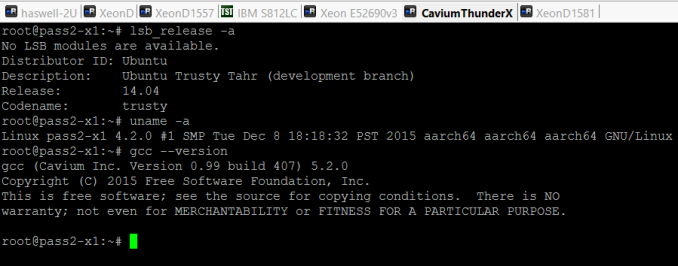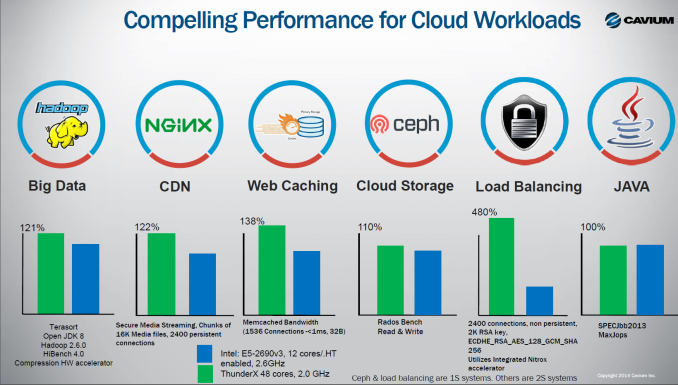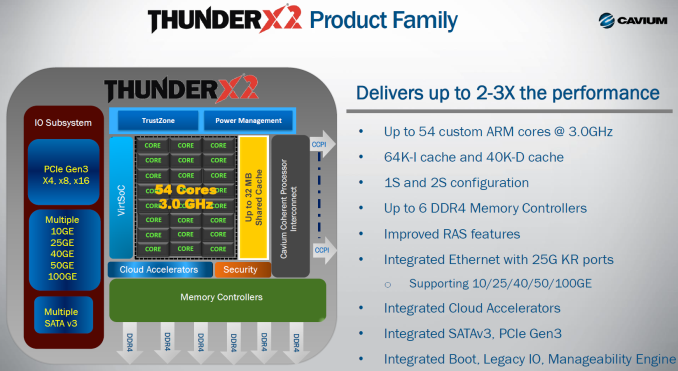Investigating Cavium's ThunderX: The First ARM Server SoC With Ambition
by Johan De Gelas on June 15, 2016 8:00 AM EST- Posted in
- SoCs
- IT Computing
- Enterprise
- Enterprise CPUs
- Microserver
- Cavium
Limitations of This Review
Before we get to our closing thoughts, I want to talk a bit about what we were and weren't able to do in our testing, and in what ways this limits our review. The still somewhat "rough on the edges" software ecosystem gave us a lot of headaches. Our setup was a Ubuntu 14.04 with lots of customized (Cavium's beta gcc compiler, MySQL version ThunderX 5.6) and newer software (the Linux kernel 4.2). The result was that we were slowed down by a large number of solvable (but time consuming) software and configuration problems.
Don't get me wrong: Linux on ARM has come a long way. Most software works, the exception was Spark 1.5 (Java based) which crashed with a very low level message. Still, it took quite a bit of time to get software configured correctly, while on x86 it is simply a matter of using "apt-get install".
Cavium told us that they expect that these problems will be solved in Ubuntu 16.04, and a firmware upgrade to support the new Ubuntu is on its way. That is also why we were not able to test our most real world and relevant benchmarks, such as our webserver tests. Webcaching, light webserving and Contend Delivery Networking might fit the ThunderX well as it has access to more memory and networking bandwidth than the Xeon D.
But webservers require a lot of software components (caching layer, webserver, interpreter etc.) that have to work together well. So we wait for 16.04 and the new firmware to arrive to build these complex tests.
Closing Thoughts
Exploring a new ambitious server SoC is always an interesting journey, but also a very time intensive one. We had to find out what the real performance profile of the ThunderX, not the perceived or advertised one. There have been both good and bad surprises in our journey.
Let's start with the bad: the blocking L1 cache, high latency L2-cache and high latency DRAM access are lowering the scalability of the 48 cores in a whole range of software. The ThunderX could still be a good candidate as front-end webserver, but Cavium has to solve the high power usage at low loads. Power management seems to be more problematic than single-threaded performance. Cavium promises that ThunderX2 will vastly improve power management by letting hardware handle much more of the management duties. But the current ThunderX power management capabilities seem to be rather basic. Cavium's information is sketchy at best.
The Xeon D, by comparison, offers superior performance per watt: twice as good as the ThunderX. It is clear that the ThunderX is not a good match for heavy database servers, nor for enterprise workloads where energy consumption at low load is a high priority.
The good. The 12 and 16-core Xeon Ds ($1300-$1800) and midrange E5s ($900-$2000, not including 10 GBe NICs) cost quite a bit more than the ThunderX ($800). Gigabyte could not tell us how much the R120-T30 would cost, only that the pricing would be "competitive with similar midrange Xeon E5 servers".
Although single-threaded performance is low, it is definitely not as terrible as commonly assumed. We found out that the raw integer computing power of the Thunder-X is about one-third that of the best Xeon Ds, not one-fifth as claimed in advertising materials (a difference of 65%). The ThunderX core is almost as good as the A57, while it consumes quite a bit less power and thus offers a better performance-per-watt than the latter. On the condition that you give it enough DRAM, the 48 cores are able to offer the Java performance of a midrange Xeon E5, even when we expect the system to remain under a certain response time.
Those facts – better than expected single threaded performance and midrange Xeon E5 throughput – make a world of difference. And we have yet to test the ThunderX in situations that is was really built for: network-intensive ones. The XML processing and h264 substests (SPEC CPU) indicate that there is definitely some truth in Cavium's claims that the ThunderX shines as a compute engine of a load balancer, web cache or CDN server.
As single threaded performance (SPEC CPU) is not as dramatic as commonly assumed and Java performance is already very close to what was promised, this puts the forthcoming ThunderX2 in a different light.
Using the new 14 nm FinFET technology of GlobalFoundries, Cavium claims it will reach 2.6-3.0 GHz and get a lot of microarchitectural improvements. This should result in twice as much performance per core. If indeed the ThunderX2 can offer single threaded performance at the level of the low end Xeon D (1.3-1.5 GHz), that might place it in the "SoCs with acceptable single threaded performance" and opens up new markets. Time will tell, but Cavium has proven it can deliver SoCs in a timely manner. And the fact that Cavium allows independent testing instead of just showing numbers on PowerPoint presentations tell us that they have confidence in the future of their ARMv8 endeavors.













82 Comments
View All Comments
Daniel Egger - Wednesday, June 15, 2016 - link
I could hardly disagree more about the remote management of SuperMicro vs. HP. Remote management of HP is *the horror*, I've never seen worse and I've seen a lot. It's clunky, it requires a license to be useful (others do to but SuperMicro does not have such nonsense), the BCM tends to crash a lot (which is very annoying for a remote management solution), boot is even slower than all other systems I know due to the way they integrate the BIOS and remote management on the system and it also uses Java unless you have Windows machines around to use the .NET version.For the remote management alone I would chose SuperMicro over most other vendors any day.
JohanAnandtech - Thursday, June 16, 2016 - link
I found the .Net client of HP much less sluggish, and I have seen no crashing at all. I guess there is no optimal remote management client, but I really like the "boot into firmware" option that Intel implemented.rahvin - Thursday, June 16, 2016 - link
Not only that but Supermicro actually releases updates for their BCM's. I had the same shocked reaction to the HP claim. Started to wonder if I was the only one that thought supermicro was light years ahead in usability.I should note that Supermicro's awful Java tool works on Linux as well as windows. Though it refuses to run if your Java isn't the newest version available.
pencea - Wednesday, June 15, 2016 - link
All these articles and yet still no review for the GTX 1080, while other major sites have already posted their reviews of both 1070 & 1080. Guru3D already has 2 custom 1080 and a custom 1070 review up.Ryan Smith - Wednesday, June 15, 2016 - link
It'll be done when it's done.pencea - Wednesday, June 15, 2016 - link
Unacceptably late for something that should've been posted weeks ago.Meteor2 - Thursday, June 16, 2016 - link
Will anyone read it though? Your ad impressions are going to suffer.Ryan Smith - Thursday, June 16, 2016 - link
Maybe. Maybe not. But it's my own fault regardless. All I can do is get it done as soon as I reasonably can, and hope it's something you guys find useful.name99 - Thursday, June 16, 2016 - link
Give it a freaking rest. No-one is impressed by your constant whining about this.pencea - Thursday, June 16, 2016 - link
Not looking to impress anyone. As a long time viewer of this site, I'm simply disappointed that a reputational site like this is constantly late for GPU reviews.